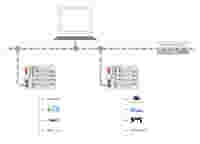Fast Communication between Automation and Field Devices: MODBUS
Advantages with MODBUS:
- Uniform data exchange compliant with standards
- Very fast data transmission
- Independent of technology and manufacturer
The well-established MODBUS protocol has become the de facto standard. It extends the MODBUS protocol familiar since 1979 for programmable logic controllers. The advantage: MODBUS is a streamlined protocol that ensures ultra-fast ETHERNET data transmission. A manufacturer-independent data structure also permits communication between devices from different manufacturers.
MODBUS enables connecting a master (e.g., a PC) and several slaves (e.g., measurement and control systems). There are two versions: One for the serial interface (RS-232 and RS-485) and one for ETHERNET.
The following data transmission operating modes are distinguished:
MODBUS TCP establishes client/server communication. The only requirement is that the nodes are in the same IP address range.
An additional setting is made through the device address; however, this cannot be done manually on products from every manufacturer. For example, you can use the device address to reach the MODBUS RTU node connected to the Gateway by addressing the latter’s IP address via a MODBUS-TCP-MODBUS-RTU Gateway. Since 2007, MODBUS/TCP has been specified in the standard IEC 61158 and is referenced in IEC 61784-2 as CPF 15/1.

MODBUS System Graphics
MODBUS RTU establishes a serial master/slave communication via RS-232 or RS-485. In order to address the MODBUS RTU, first the serial communication parameters must be known and/or defined. These parameters include baud rate, parity and stop bits. The slave address(es) to be addressed by the master also come into play. In this case, conductor length with RS-232 is limited to 15 m and with the RS-485, 1200 m.
Recommended Reading
Related to MODBUS
Whether inside or outside the control cabinet, WAGO’s I/O Systems provide automation right where you need it – even under harsh conditions.

WAGO’s Touch Panels (HMI panels) not only improve the operability of machines and systems, but also offer an outstanding design and advanced technology.
